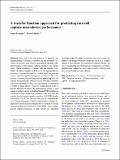A transfer function approach for predicting rare cell capture microdevice performance
Author(s)
Smith, James P.; Kirby, Brian J.
Download10544_2015_Article_9956.pdf (900.1Kb)
PUBLISHER_POLICY
Publisher Policy
Article is made available in accordance with the publisher's policy and may be subject to US copyright law. Please refer to the publisher's site for terms of use.
Terms of use
Metadata
Show full item recordAbstract
Rare cells have the potential to improve our understanding of biological systems and the treatment of a variety of diseases; each of those applications requires a different balance of throughput, capture efficiency, and sample purity. Those challenges, coupled with the limited availability of patient samples and the costs of repeated design iterations, motivate the need for a robust set of engineering tools to optimize application-specific geometries. Here, we present a transfer function approach for predicting rare cell capture in microfluidic obstacle arrays. Existing computational fluid dynamics (CFD) tools are limited to simulating a subset of these arrays, owing to computational costs; a transfer function leverages the deterministic nature of cell transport in these arrays, extending limited CFD simulations into larger, more complicated geometries. We show that the transfer function approximation matches a full CFD simulation within 1.34 %, at a 74-fold reduction in computational cost. Taking advantage of these computational savings, we apply the transfer function simulations to simulate reversing array geometries that generate a “notch filter” effect, reducing the collision frequency of cells outside of a specified diameter range. We adapt the transfer function to study the effect of off-design boundary conditions (such as a clogged inlet in a microdevice) on overall performance. Finally, we have validated the transfer function’s predictions for lateral displacement within the array using particle tracking and polystyrene beads in a microdevice.
Date issued
2015-05Department
Lincoln LaboratoryJournal
Biomedical Microdevices
Publisher
Springer US
Citation
Smith, James P., and Brian J. Kirby. “A Transfer Function Approach for Predicting Rare Cell Capture Microdevice Performance.” Biomedical Microdevices 17.3 (2015): n. pag.
Version: Author's final manuscript
ISSN
1387-2176
1572-8781